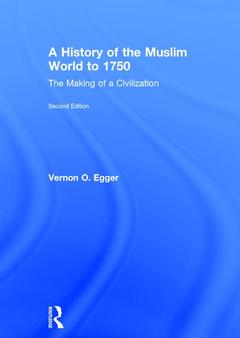Description
A History of the Muslim World to 1750 (2nd Ed.)
The Making of a Civilization
Author: Egger Vernon O.
Language: English
Subject for A History of the Muslim World to 1750:
Keywords
Dar Al Islam; Byzantine Empire; Muslim World; Sasanian Empire; Young Men; Arabian Peninsula; Alamy Stock Photo; Mecca; Aral Sea; Muhammad; Abd Al Rahman III; Arabia; Abd Allah; Arab; Indian Ocean Basin; Arab conquests; Umayyad Dynasty; Iran; Abbasid Caliph; North Africa; Golden Horde; Iberian Peninsula; Sasanian Empires; Central Asia; Central Government; Indus River Valley; umayyad; caliphate; Arabic Language; Abbasid; Eastern Anatolia; Sunni; Ibn Tashfin; Ghulat; Delhi Sultanate; Husayni Alids; Mamluk Empire; Shi'ite movement; Muhammad Ibn Tughluq; Fatimid Caliphate; Safavid Empire; Islamic Law; Great Saljuqs; sufism; Ibn Al Shatir; science; Western Sahara; philosophy; Islamic theology; Vernon O; Egger
Publication date: 11-2017
· 17.4x24.6 cm · Hardback
Publication date: 12-2017
· 17.4x24.6 cm · Paperback
Description
/li>Contents
/li>Readership
/li>Biography
/li>
A History of the Muslim World to 1750 traces the development of Islamic civilization from the career of the Prophet Muhammad to the mid-eighteenth century. Encompassing a wide range of significant events within the period, its coverage includes the creation of the Dar al-Islam (the territory ruled by Muslims), the fragmentation of society into various religious and political groups including the Shi'ites and Sunnis, the series of catastrophes in the twelfth and thirteenth centuries that threatened to destroy the civilization, and the rise of the Ottoman, Safavid, and Mughal empires.
Including the latest research from the last ten years, this second edition has been updated and expanded to cover the fifteenth to eighteenth centuries. Fully refreshed and containing over sixty images to highlight the key visual aspects, this book offers students a balanced coverage of the Muslim world from the Iberian Peninsula to South Asia, and detailed accounts of all cultures. The use of maps, primary sources, timelines, and a glossary further illuminates the fascinating yet complex world of the pre-modern Middle East.
Covering art, architecture, religious institutions, theological beliefs, popular religious practice, political institutions, cuisine, and much more, A History of the Muslim World to 1750 is the perfect introduction for all students of the history of Islamic civilization and the Middle East.
Part One: The Formative Period, 610–950; 1. Origins; 2. Arab Imperialism; 3. The Development of Sectarianism; 4. The center cannot hold: Three Caliphates; 5. Synthesis and Creativity Part Two: Civilization vs. Chaos, 950–1260; 6. Filling the Vacuum of Power, 950–1100; 7. Barbarians at the Gates, 1100–1260; 8. The Consolidation of Traditions; 9. The Muslim Commonwealth; Part Three: Mongol Hegemony, 1260–1405; 10. The Great Transformation; 11. Unity and Diversity in Islamic Traditions; Part Four: Muslim Ascendancy, 1405–1750; 12. The Central Muslim Lands; 13. The Umma in the West; 14. Central Asia and Iran; 15. South Asia; 16. The Indian Ocean
Vernon O. Egger is Professor Emeritus of Middle Eastern and Islamic History at Georgia Southern University. His other books include The Muslim World Since 1260 and A Fabian in Egypt: Salamah Musa and the Rise of the Professional Classes in Egypt, 1909–1939.




